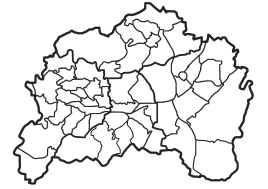Clemenshammer
|
Clemenshammer
City of Remscheid
Coordinates: 51 ° 12 ′ 10 ″ N , 7 ° 10 ′ 0 ″ E
|
||
|---|---|---|
| Height : | 162 m above sea level NN | |
| Postal code : | 42855 | |
| Area code : | 02191 | |
|
Location of Clemenshammer in Remscheid |
||
|
View in Clemenshammer
|
||
Clemenshammer is a residential area belonging to the North Rhine-Westphalian city of Remscheid with a good 80 inhabitants.
location
The place of residence is in the north of Remscheid near the city limits to Wuppertal . Today it belongs to the districts of Alt-Remscheid ( district Kratzberg ) and Lüttringhausen (district Lüttringhausen-West ). Until the founding of the large Berg cities in 1929, the village was divided into the then independent cities of Remscheid, Lüttringhausen and Cronenberg .
Clemenshammer is located in the Morsbach valley at the confluence of the Gelpe and the Morsbach .
History and economy
Clemenshammer was first mentioned in 1580 when Clemens auf dem Hammer and Friedrich vom Dohr bought an ironworks . However, this must inevitably be older than the first documentary mention. In 1607 a grinding bowl was added. In the course of time, due to the favorable conditions (water power to drive the forging hammers , bellows and whetstones , and the wood and charcoal deposits ), several hammer, forge and grinding cabins settled here.
There were up to four hammers here : the Bollenhammer, the Rottsiepershammer, the Schliepershammer and the Steffenshammer , which is the only one that is still fully functional and can be visited on a few Saturdays as a branch of the German Tool Museum Historical Center .
In 1902, the hammer smith and leaseholder of the Bollenhammer Ferdinand Flüs bought a ship-like water slide for 18,000 gold marks and opened the Flüs garden restaurant on May 31, 1903. The water slide, which used the steep gradient from today's Kratzberger Straße into the Hammerteich, developed into one of the greatest attractions in the Bergisches Land. The electricity for the electric winch that pulled the slide up the slope was obtained by means of a generator that was flanged to the water wheel of the Bollenhammer. Until the installation of a splash guard and a canopy with canvas, the ride on the slide was associated with the complete soaking of the passengers, which initially made it less attractive.
The competition was not long in coming; The Schlieper inn opened shortly afterwards on the opposite side of the Cronenberg and set up terrace seats with a view of the river's water slide, which led to a tangible guerrilla war between the two fresh hosts. Meter-high wooden fences soon blocked the view.
After ten years, Flüs leased his restaurant and his successor came up with a new attraction: a wooden toboggan run. After only two weeks, the police declared the facility as "life threatening" and had it closed. The new tenant was broke and left the valley. The garden restaurant was bought by the Lohmann family in 1921/22 and operated until 1952; the pond was filled in in the 1940s.
During the Second World War , 120 Eastern workers were housed in the buildings belonging to the Bollenhammer.
There are still some mostly family-owned metalworking companies, especially in the tool, hardware and small iron industry.
traffic
The Morsbachtalstraße (today L 216 ) runs through the Morsbachtal .
On November 16, 1891, the villages in the Morsbach valley were connected to the Ronsdorf-Müngstener railway . The meter-gauge railway , which was electrified in 1903, was primarily used to transport the raw materials required by the companies and the goods produced. With the exception of excursion traffic, it did not play a significant role in passenger traffic.
Clemenshammer did not have its own stop. The next train station was only a few hundred meters to the west near the village of Gerstau , and another stop was to the east at Platz . On November 26, 1954, the Morsbach - Gründerhammer section of the railway line, which also ran through Clemenshammer, was shut down.
Today, the best way to get to the Honschaft is by public transport via the Gerstau bus stop (line 615) and an occasional citizen's bus . In addition, the 680 bus to Hasten operates twice a day from the "Clemenshammer" stop, as well as an hourly call-and-collect taxi to Morsbach.
There are several parking spaces for hikers in the village at the entrance to the historic Gelpe Valley industrial history trail .
Literature and Sources
- Egon Viebahn; Hammers and grinding balls in the Gelpetal ; Born publishing house; Wuppertal 1983; ISBN 3-87093-033-0 (extended new edition 2003)
- Günther Schmidt; Hammer and Kotten research in Remscheid , Volume 3: from Gerstau to Haddenbach with Gelpetal and Ibach ; Publisher: Buchhandlung R. Schmitz; Remscheid; 2002; ISBN 3-98000773-1

